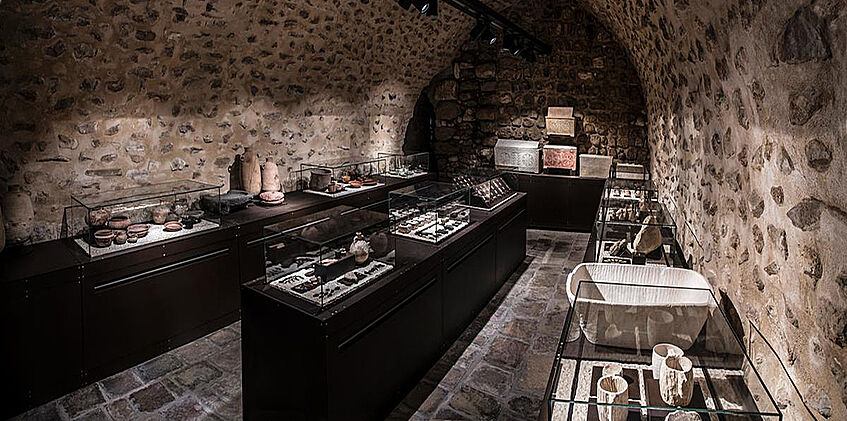Terra Sancta Museum in Jerusalem

(c) Neva Gasparo
Promoter Institutions
The Custody of the Holy Land, Studium Biblicum Franciscanum, Faculty of Biblical Sciences and Archeology of the Pontifical Universitas Antonianum of Rome, The Association pro Terra Sancta, NGOs at the service of the Custody of the Holy Land.
Curating and research
p. Eugenio Alliata (scientific director), Gabriele Allevi, Daniela Massara, Davide Bianchi
Project for architectural restoration and museum layout
GTRF Tortelli Frassoni Architetti Associati
Works Directorate
Giovanni Tortelli with Alessandro Polo
Realization of architectural works
Technical office of the Custody of the Holy Land
The Franciscans of the Custody of the Holy Land inaugurated in 2018 the TERRA SANCTA MUSEUM in Jerusalem, the only museum in the world on the roots of Christianity and the preservation of the Holy Places. The Museum, with an exhibition area occupying 2,573 m2, has three sections: Archaeological, Historical and Multimedia.
The archaeological section consists of archaeological finds from the excavations carried out over the past 150 years in the Holy Land. Particularly, the archaeological places related to the life of Jesus: Bethlehem, Nazareth, Capernaum (with the house of St. Peter), Galilee (Tabgha and Cana), and Jerusalem (Holy Sepulchre and Gethsemane). In the first wing of the archaeological section (opened in June 2018), through a six-room exhibition, the visitors can discover objects related to the political institutions of the Herodian age, the daily life at the time of the New Testament, up to the first Monastic experiences. A fascinating journey in ancient structures rescued and restored for this occasion: a byzantine cistern, Crusader rooms, a wonderful courtyard surrounded by Mameluke structures. The collections show painting materials (frescoes), ceramics and sculptures, Byzantine mosaics, coins, fragments of plates, architectural materials (Crusader capitals), jars from Bronze Age tombs, sarcophagi, alabasters, jewels (scarabs, seals and cameos), lamps, inscribed ossuaries, etc., ranging chronologically from the Canaanite period (2nd millennium BC) to the medieval Crusaders (11th - 12th centuries AD). There are also special collections from Egypt and Mesopotamia.
Bibliography
- D. Bianchi, In merito ad un polyangistron dalla cosiddetta Insula Sacra di Cafarnao, in F. Ciliberto (ed.) Dietro le quinte del Terra Sancta Museum di Gerusalemme, Roma 2022, 69-79.
- D. Bianchi, 15 Katalogbeiträge in: S. Cibin (ed.), Selected Works from the collections of the Terra Sancta Museum, Milan 2019.
- D. Bianchi, In margine ad una placchetta dedicata a san Giorgio, in F. Ciliberto (ed.), Tra servizio civile e missioni estere: il contributo dell’Italia ai Beni Culturali della Terra Santa, Roma 2018, 45-60.
- D. Bianchi, Due polycandela dal museo archeologico dello Studium Biblicum Franciscanum, in G.C. Bottini, C. Churpcała, J. Patrich (eds.) Knowledge and Wisdom. Archaeological and Historical Essays in Honour of Leah Di Segni, Milano 2014, 364-370.
- Bellarmino Bagatti, Il museo della flagellazione in Gerusalemme, 1939.
- Michele Piccirillo, Studium Biblicum Franciscanum. Attività storico-archeologiche ed esegetiche, 1982.
- Eugenio Alliata, Studium Biblicum Franciscanum – Museo Archeologico, 2011.
- https://www.terrasanctamuseum.org/en/
Univ.-Ass.Dott. Dott. mag. Davide Bianchi, PhD
e-mail: davide.bianchi@univie.ac.at
